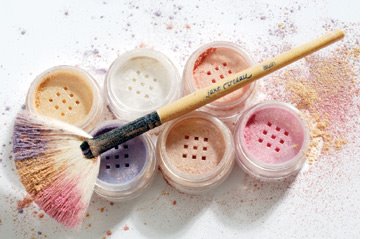Skin care companies add preservatives to keep bacteria out of products. But a new medical review questions whether many “over preserve” products – and in the process increase serious health risks for women. Here’s what you need to know. – By Colette Bouchez

If you’ve ever developed a red itchy rash – or even a case of hives – after using a skin cream, body lotion, a shower gel or even a foundation, then you’ve already come in contact with “Contact Dermatitis” – a type of allergic skin reaction that often develops in response to chemical preservatives used to keep these products fresh on the shelf.
Now a new medical review out of Denmark claims so many manufacturers are now overloading their products with these questionable chemicals, the risk of getting a reaction grows more likely every day.
" Allergy to preservatives is one of the main reasons for contact eczema caused by cosmetics. As development and elicitation of contact allergy is dose dependent, the over preservation of cosmetics potentially leads to increased incidences of contact allergy, “ says study author Michael Dyrgaard Lundov, a researcher from the Department of Dermatology, National Allergy Research Centre, Gentofte University Hospital in Denmark. His research was just published in the journal
Contact Dermatitis.
Preservatives are necessary to control the growth of bacteria in any product that contains water. Among the most harmful of those bugs are pathogenic micro-organisms such as Staphylococcus aureus and Pseudomonas aeruginosa. Both can lead to serious, even life threatening infections, and both are frequently found in contaminated cosmetics.
But while there are some 50 approved preservatives available to help keep these and other harmful pathogens under control, the new review also found the market is dominated by a just a few: parabens, formaldehyde, formaldehyde releasers, metylchloroisothiazolinone, and methylisothiazolinone.
Overuse of these chemicals may be especially bad since studies show they are also among the most irritating chemical preservatives in use today.
“Approximately 6% of the general population has a cosmetic-related contact allergy mainly caused by preservatives and fragrances,” says Lundov.
Moreover, in the US, the patch tested prevalence of allergies to formaldehyde is as high as 9%, according to Lundovs' research paper.
Cosmetic s & Chemicals: More Problems on the Horizon?
As irritating as contact dermatitis can be experts like Vassar’s Dr. Janet Gray say they are less concerned about skin rashes and localized allergies then they are about the potential of long term health consequences linked to overdosing – including an increased risk of cancer.
Indeed, at least some of these chemical preservatives have already been identified by the World Health Organization, the CDC as others as carcinogens, while at least one study found parabens had been collected and stored in what turned out to be malignant breast tissue. And while there is no clear indication that the parabens either caused, or even exacerbated a malignancy, it's an association that has a number of researchers worried.
"The evidence may not be as definitive as some would like, but there are some strong associations suggesting women, particularly younger women, routinely exposed to some of these ingredients may increase their risk of developing breast cancer later in life," says Gray, who, together with experts from the University of Pittsburgh Cancer Institute compiled a report on what we know thus far about the environmental links to breast cancer.
In the US these concerns may be even more significant since manufacturers and importers are not required by law to report to the FDA which preservatives they even use in a product, let alone how much. Any reporting that does take place is strictly voluntary. Indeed, a passage straight from the FDA's own website confirms that, “[Cosmetic] Manufacturers may use any ingredient or raw material, except for color additives and a few prohibited substances, to market a product without a government review or approval."
Cosmetics & Chemicals: How To Protect Yourself
While it’s clear that some type of preservatives are necessary to give products a shelf life – and keep them affordable - Lundov and his group believe we can cut a great many of the risks by simply cutting down on the amount used in these products.
But that may be easier said than done. Determining the threshold at which bacteria does get out of hand is going to require some serious – and expensive – medical testing. And right now, it appears as if manufacturers would simply rather over-dump then pay the price of discovering how much of these chemicals are really necessary to strike a balance.
So what can you do in the meantime? Certainly, many natural products contain far less harmful preservatives - so that’s one shopping option. You can also cut down on some exposures by making some simple switches - from a shower gel or cream, to a bar of soap for example.
But in the end cancer prevention experts like Julia Smith, MD says avoiding one jar of face cream or one tube of foundation isn't going to make as much difference as how you live your life overall.
“Ultimately it’s going to be your cumulative exposure to all chemical and environmental toxins that matters most, “say Smith, director of the Lynne Cohen Breast and Ovarian Cancer Prevention Center at the NYU Cancer Center in New York City.
So, in this respect Smith says cut down on exposures when and where you can , eliminate those products that are not important to you, then use the products you really think you need without excess fear or worry.
"You do what you can, and hope it might make a positive difference in your life”, says Smith.
Mineral Makeup - UNCOVERED!
Fragrance Allergies Cause More Than Sneezing!Copyright by Colette Bouchez 2009 - All Rights Reserved.
In addition to US Copyright, the text of this RedDressDiary article is licensed under a Creative Commons Attribution-ShareAlike 3.0 License. All formatting and style elements of this page are not available under this license, and Colette Bouchez retains all rights in those elements.
 If you’ve ever developed a red itchy rash – or even a case of hives – after using a skin cream, body lotion, a shower gel or even a foundation, then you’ve already come in contact with “Contact Dermatitis” – a type of allergic skin reaction that often develops in response to chemical preservatives used to keep these products fresh on the shelf.
If you’ve ever developed a red itchy rash – or even a case of hives – after using a skin cream, body lotion, a shower gel or even a foundation, then you’ve already come in contact with “Contact Dermatitis” – a type of allergic skin reaction that often develops in response to chemical preservatives used to keep these products fresh on the shelf.




































